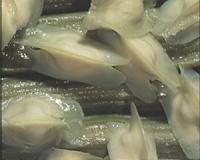| . |  |
. |
College Station TX (SPX) Mar 10, 2010 A new study by Texas AgriLife Research scientists finds that contrary to widespread perceptions, springs in the Edwards Plateau, which provide much of the stream flows, have not been declining as a result of increased encroachment of woody plants. In fact, spring flows are twice as high as they were prior to 1950. The study found that the landscape is actually recovering from intensive livestock grazing in Texas that dates back to the late 1800s. Large numbers of cattle, sheep and goats continuously grazing rangelands led to widespread soil degradation, partly hindering the amount of water recharging springs and groundwater, said Dr. Bradford Wilcox, a professor in the Department of Ecosystems Science and Management at Texas A and M University and one of the authors of the study, which is to be published in the journal Geophysical Research Letters, a publication of the American Geophysical Union. "The study took place in the Edwards Plateau region of Central Texas, the primary water source for the Edwards Aquifer, which provides water for San Antonio and numerous smaller municipalities," he said. "This area was basically converted from grassland to a shrubland after many years of heavy livestock grazing. What people have forgotten is that in the time period between healthy grasslands and the current shrublands, there was an extended period when the land was quite degraded. Subsequent to 1960, livestock numbers have declined and the landscape has recovered although there are now more cedar than in the past." From 1880 to 1900, there were more animals on the land than it could support. In fact, for a short period of time, stocking rates at the turn of the last century were 10 times greater than current levels, Wilcox said. However, as fewer cattle and other livestock were used on the land as part of agricultural production since the late 1900s, the region has gone through revitalization. "As a result, these landscapes are recovering, but they've also converted to woody plants," he said. "We're also seeing large-scale increases in the amount of spring flows. This is opposite of what everybody is presuming - the trees are there and they are sucking up all of this water. The trees are actually allowing the water to infiltrate. There's is a broad perception that the trees are making these natural springs disappear. This is definitely not the case." The results of the study suggest that the Edwards Aquifer recharge is "higher than it used to be." "I think the results from this study are pretty strong evidence that this is the case," Wilcox said. Wilcox said what hasn't been researched is if woodlands were restored back to well-managed savannas, if there might be further increases in spring flow. The increasing spring flows should be seen as evidence that well-managed rangelands can result in an increase in groundwater recharge and spring flow, he said.
Share This Article With Planet Earth
Related Links Texas AgriLife Research Water News - Science, Technology and Politics
 Worlds Most Usefull Tree Provides Low-Cost Water Purification
Worlds Most Usefull Tree Provides Low-Cost Water PurificationWashington DC (SPX) Mar 08, 2010 A low-cost water purification technique published in Current Protocols in Microbiology could help drastically reduce the incidence of waterborne disease in the developing world. The procedure, which uses seeds from the Moringa oleifera tree, can produce a 90.00% to 99.99% bacterial reduction in previously untreated water, and has been made free to download as part of access programs under ... read more |
|
| The content herein, unless otherwise known to be public domain, are Copyright 1995-2010 - SpaceDaily. AFP and UPI Wire Stories are copyright Agence France-Presse and United Press International. ESA Portal Reports are copyright European Space Agency. All NASA sourced material is public domain. Additional copyrights may apply in whole or part to other bona fide parties. Advertising does not imply endorsement,agreement or approval of any opinions, statements or information provided by SpaceDaily on any Web page published or hosted by SpaceDaily. Privacy Statement |